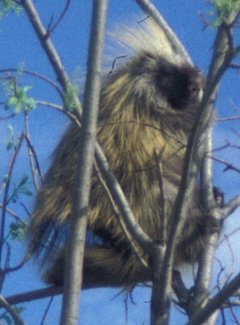Porcupine
|
|
| Porcupines | ||||||||||
|---|---|---|---|---|---|---|---|---|---|---|
 North American Porcupine | ||||||||||
| Scientific classification | ||||||||||
| ||||||||||
| Genera | ||||||||||
|
Family Erethizontidae |
The porcupine is a rodent known for its coat of sharp spines, or quills that defend it from predators. The porcupine is the third largest rodent, after the capybara and the mara. Most porcupines are about 63 to 91 cm (25 to 36 inches) long, with an 20- to 25- cm (8- to 10-inch) long tail. Weighing between 5.4 and 16 kg (12 and 35 pounds), they are rounded, large, and slow. Porcupines come in various shades of brown and the unusual white. The name "porcupine" comes from combining the Latin for pig and French for spine, hence the nickname "quill pig" for the animal.
In parts of Africa, porcupines are eaten as a form of bush meat.
| Contents [hide] |
Quills
The porcupine's chief defense is its quills, sharp spines distributed across the rodent's back, sides, legs, tail, and head. They may be as dense as 150 per square inch, giving one animal as many as 30,000 quills. Porcupines do not throw their quills; unfortunate attackers approach closely enough to be swatted by the tail or brush against the animal. Like the related ordinary hairs, porcupine quills grow back when they come out.
When threatened, a porcupine will raise its quills. This is the piloerection reflex, the same as the goose bump reflex in humans.
A porcupine can defend itself by hiding its bare face from an attacker and keeping its bare belly to the ground. It may swat its tail at an assailant. Fishers sometimes successfully attack porcupines by biting their faces. Quills are not poisoned, but animals may die from a porcupine encounter if the quills prevent eating. Porcupines often fall on their own quills. Likely as an evolutionary result, the quills possess mild antibiotic properties.
Quills are sharp-pointed, fitted with microscopic barbs, and expand on contact with warm flesh. Muscle contractions in a quill victim work the quill deeper, as much as an inch per day unless quills are removed promptly.
Habitat
Porcupines occupy a wide range of habitats in tropical and temperate parts of Asia, Italy, Africa and the Americas. Porcupines live in forests, deserts, and grassland. Some live in trees, others stay on the ground.
Porcupines in search of sodium sometimes encroach on areas inhabited by people and eat tool handles, clothes, and other items that have been coated in salty sweat.
Species
A porcupine is any of 23 species of rodent belonging to the families Erethizontidae and Hystricidae. All defend themselves with sharp spines (which are actually modified hairs) rather like those of the hedgehogs, which are part of the order Insectivora and more closely related to shrews and moles than they are to the rodents, and the echidnas, which as monotremes are very distantly related indeed.
Porcupines vary in size considerably: Rothschild's Porcupine of South America weighs less than a kilogram; the African Porcupine can grow to well over 20 kilograms.
The two families of porcupines are quite different and although both belong to the Hystricognathi branch of the vast order Rodentia, they are not closely related.
The 11 Old World porcupines are almost exclusively terrestrial, tend to be fairly large, and have quills that are grouped in clusters. They separated from the other hystricognaths about 30 million years ago, much earlier than the New World porcupines.
The 12 New World porcupines are mostly smaller (although the North American Porcupine reaches about 85 cm in length and 18 kilograms), have their quills attached singly rather than grouped in clusters, and are excellent climbers, spending much of their time in trees. The New World porcupines developed their spines independently, and are more closely related to several other families of rodent than they are to the Old World porcupines.
- ORDER RODENTIA
- Suborder Sciurognathi: about 1750 species including squirrels, rats, mice, and many others.
- Suborder Hystricognathi
- Family Hystricidae: Old World porcupines
- African Brush-tailed Porcupine, Atherurus africanus
- Asiatic Brush-tailed Porcupine, Atherurus macrourus
- African Porcupine, Hystrix cristata
- Cape Porcupine, Hystrix africaeaustralis
- Himalayan Porcupine, Hystrix hodgsoni
- Indian Porcupine, Hystrix indicus
- Malayan Porcupine, Hystrix brachyura
- Bornean Porcupine, Thecurus crassispinis
- Philippine Porcupine, Thecurus pumilis
- Sumatran Porcupine, Thecurus sumatrae
- Long-tailed Porcupine, Trichys fasciculata
- Family Thryonomyidae: cane rats
- Family Petromuridae: Dassie Rat
- Family Bathyergidae: African mole-rats
- Family Hydrochaeridae: capybara
- Family Caviidae: cavies
- Family Dasyproctidae: agoutis and acouchis
- Family Erethizontidae: New World porcupines
- Brazillian Porcupine, Coendou prehensilis
- Bicolor-spined Porcupine, Coendou bicolor
- Koopman's Porcupine, Coendou koopmani
- Rothschild's Porcupine, Coendou rothschildi
- Mexican Tree Porcupine, Sphiggurus mexicanus
- South American Tree Porcupine, Sphiggurus spinosus
- Bahia Hairy Dwarf Porcupine, Sphiggurus insidiosus
- Pallid Hairy Dwarf Porcupine, Sphiggurus pallidus (extinct)
- Brown Hairy Dwarf Porcupine, Sphiggurus vestitus
- Orange-spined Hairy Dwarf Porcupine, Sphiggurus villosus
- North American Porcupine, Erethizon dorsatum
- Stump-tailed Porcupine, Echinoprocta rufescens
- Family Chinchillidae: chinchillas and allies
- Family Ctenomyidae: tuco-tucos
- Family Myocastoridae: Coypu
- Family Octodontidae: octodonts
- Family Ctenodactylidae: gundis
- Family Hystricidae: Old World porcupines
External links
- How do porcupines make love? (http://paulding.net/porcupine.html)
- Pacific Northwest National Laboratory: Porcupines (http://www.pnl.gov/pals/resource_cards/porcupines.stm)fr:Porc-épic
